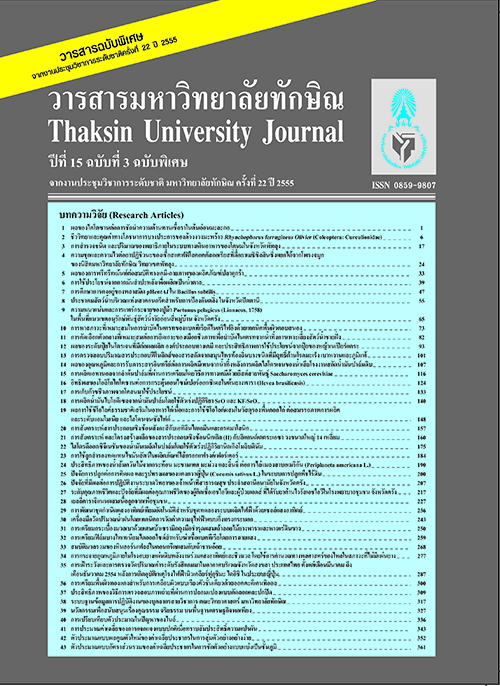การเตรียมพื้นผิวทองแดงสำหรับการเคลือบผิวแบบเรียงตัวชั้นเดียวด้วยออคตะดีเคนทิออล
Main Article Content
Abstract
วิธีการเคลือบผิวแบบเรียงตัวชั้นเดียวด้วยออคตะดีเคนทิออล (ODT) บนพื้นผิวทองแดงมีสองขั้นตอน สำคัญ คือ การเตรียมพื้นผิวทองแดง และการนำไปแช่ในสารละลาย ODT เข้มข้น 0.01 M ในไอโซโพรพานอล งานวิจัยนี้มีวัตถุประสงค์เพื่อหาวิธีการเตรียมพื้นผิวทองแดงที่เหมาะสมก่อนการเคลือบด้วย ODT โดยเปรียบเทียบ การเตรียมผิวทองแดงด้วยวิธีออกซิเจนพลาสมากับวิธีอื่นๆ ได้แก่ ขัดด้วยกระดาษทราย แช่ใน HNO3HClH2O2 H2O2 และตามด้วย HNO3 สารละลายปิรันยา และ H3PO4 ทดสอบด้วย contact angle SEM surface roughness tester AFM และ potentiostats ใน 0.5 M NaCl ผลแสดงว่า การเตรียมผิวทองแดงด้วยวิธีออกซิเจนพลาสมาให้พื้นผิว มีสมบัติความไม่ชอบน้ำมากที่สุด มีมุมสัมผัส 154.94° และมีประสิทธิภาพของการป้องกันการกัดกร่อนสูงที่สุด เท่ากับ 99.62% พื้นผิวที่เตรียมโดยการขัดด้วยกระดาษทราย แช่ใน H2O2HCl และออกซิเจนพลาสมามีความขรุขระ ประมาณ 0.02 µm ส่วนพื้นผิวของวิธีแช่ใน HNO3 สารละลายปิรันยา และ H3PO4 มีความขรุขระมากกว่า 0.2 µm สรุปว่าออกซิเจนพลาสมาเป็นวิธีการเตรียมฟิล์มซึ่งมีพื้นผิวเรียบที่สุด และให้การป้องกันการกัดกร่อนที่ดี
The method to prepare octadecanethiol (ODT) SAMs on copper surface involves two important steps. Copper surface is activated and then immersed in 0.01 M ODT in isopropanol. The aim of this present study is to investigate the effect of copper surface activation method. We investigated oxygen plasma treatment and compared with other existing methods including polishing surface with emery paper, immersing in HNO3, HCl, H2O2, H2O2 and then HNO3, piranha solution and H3PO4. The passivating films obtained were then characterized by using contact angle test, SEM, surface roughness tester, AFM and potentiostats measurement in 0.5 M NaCl. The results show that the film prepared by oxygen plasma treatment, yields the highest hydrophobic feature with contact angle of 154.94° and the highest inhibition efficiency of 99.62%. The surface treatment methods using polishing, H2O2, HCl, and oxygen plasma produce smooth passivating films with surface roughness around 0.02 µm. In comparison, the treatment methods using HNO3, piranha solution and H3PO4 produce rough passivating films with surface roughness about 0.2 µm. In conclusion, the oxygen plasma treatment is excellent method toproduce a smooth passivating film with high protection efficiency.


